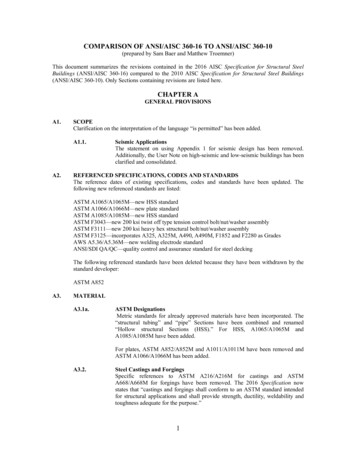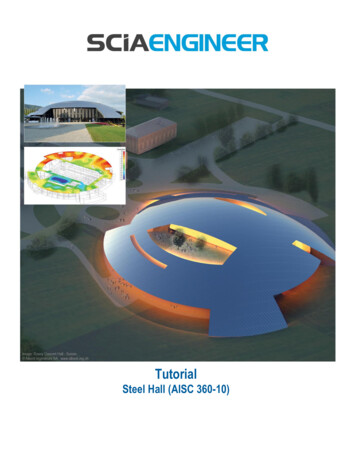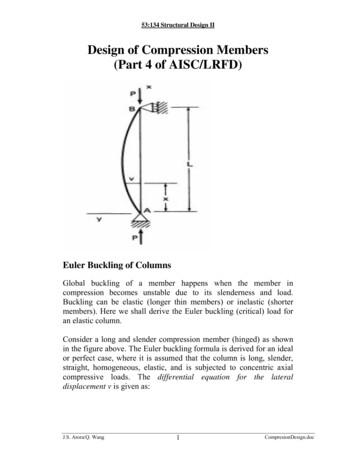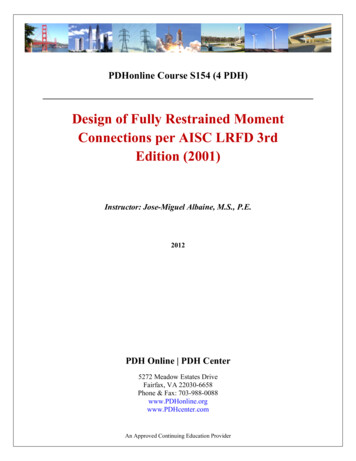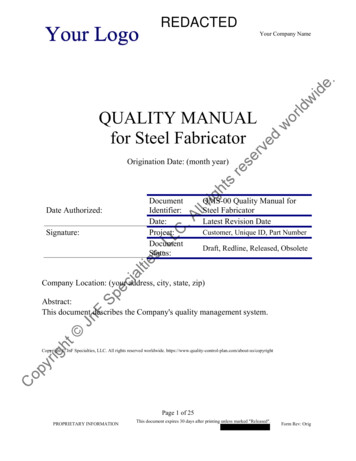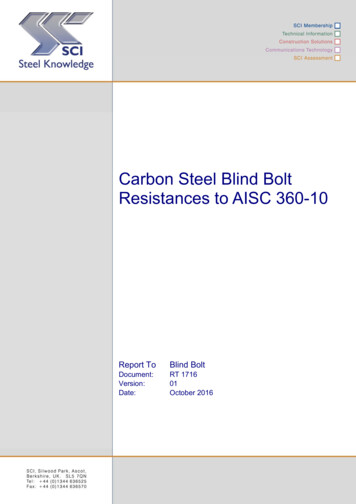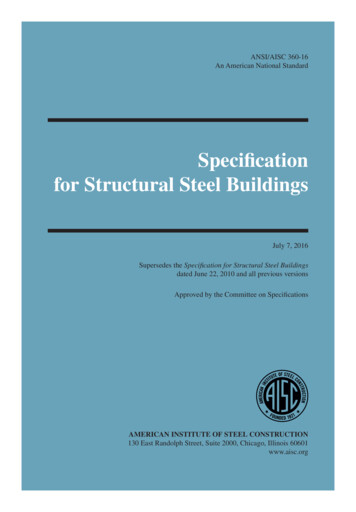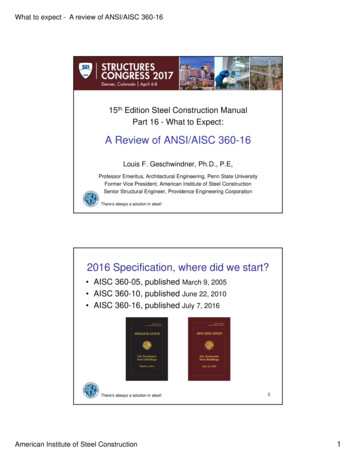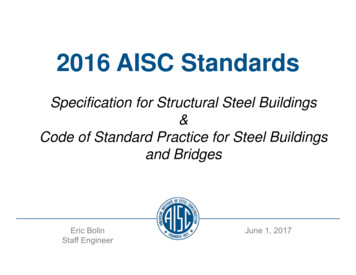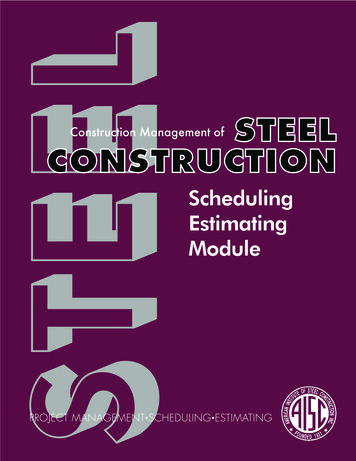
Transcription
SchedulingEstimatingModule
INDEX2SCHEDULING AND ESTIMATING 12.122.132.142.15SchedulingIntroduction to SchedulingProject Delivery Participants and CoordinationProject PhasesOverview of Steel Construction ActivitiesFabrication Related ActivitiesErection Related ActivitiesWork Breakdown StructureActivity DurationsCritical Path Method Network DiagramsBar ChartsSteel Schedule vs Overall Project ScheduleItems Impacting the ScheduleAreas Requiring Special AttentionSummaryQuestions for Classroom troductionIntroduction to EstimationPreliminary Conceptual EstimatingBidding: The Subcontractor’s RoleQuantity Takeoff MethodsCosts Included in the Fabricator’s EstimateSpecial Estimating Issues for FabricationCosts Included in the Erector’s EstimateSpecial Estimating Issues Concerning ErectionEconomy of Steel Construction and Methods for Reducing CostsPublished Sources of Estimating InformationSummaryQuestions for Classroom Discussion69697070727477828384858586Reference Sources88AppendicesA.B.B.D.Case Study DocumentsSample SpecificationsFabricator InventoryAISC Services8996105106
SCHEDULING AND ESTIMATING2.1OverviewConstruction of the structural frame for a building project is a significant and critical project phase,which represents a substantial portion of the project, in terms of time, money, equipment, andpersonnel. Structural steel, with proper planning, offers the potential for significant time and costbenefits over other structural systems. In order to take full advantage of these potential benefits,close coordination among the parties and proper planning is essential. An understanding ofstructural steel activities and their sequence, as well as their relationship to preceding andsubsequent construction phases, is important in being able to take full advantage of the schedulereductions which can be generated by using steel. Module Two is intended to introduce students toscheduling and estimating issues which are important in planning for structural steel construction.Project management and contractual aspects of steel construction were presented in Module One ofthis manual; the reader should refer as needed to Module One for supporting information which isrelevant to the scheduler and estimator.The discussions in this section are based on a typical midsize (three to ten-story) building projectsimilar to the case study discussed in section 1.2. (See case study project documents in AppendixA.) The case study project is based on a general contract form of project management. However,the issues presented in this educational module are also relevant to construction management anddesign-build project environments.SCHEDULING2.2Introduction to SchedulingThe construction of structural steel is fast paced. On-site construction time is reduced relative toother systems by fabricating steel components prior to erection. Steel may also be erected in allseasons, which provides scheduling flexibility for the overall project. The reduction of on-site timealong with scheduling flexibility can ultimately lead to significant savings in general conditionsand financing costs.The fabrication of steel components requires careful planning and close coordination among thevarious parties. Shop drawing approval, ordering of material, erection planing, fabrication,delivery, and erection activities need to be well orchestrated to ensure a streamlined, delay freeprocess. The preparation of a proper schedule of structural steel activities and integration of thisschedule into the overall project schedule are important activities in planning for structural steelconstruction.The intent of this portion of the manual is to provide students with an understanding of schedulingstructural steel construction by 1) defining the usual structural steel activities, 2) presentinginformation on sequencing and durations, and 3) discussing scheduling methods which are used inpreparing the structural steel schedule. In addition, a discussion of methods for avoiding delays instructural steel is presented.43
2.3Project Delivery Participants and CoordinationA large number of professionals are involved in the construction of a structural steel frame. Industryparticipants and their roles were discussed in detail in Module One, Section 1-5. The need forproper communication and coordination among the participants is essential for the timelycompletion of the structural steel.In order to make an effective and practical schedule for the execution of the overall project, thescheduler should understand how the roles and responsibilities of the participants impact theschedule. The steel contractor, together with the general contractor, will play primary roles incoordinating the various participants. The general contractor will facilitate communicationsbetween the designer, other subcontractors, and the steel contractor. The steel contractor willcoordinate the suppliers and lower tier subcontractors for the steel contract.2.4Project PhasesAll building construction projects consist of a series of broad construction phases. While there maybe considerable overlap and concurrent activity between the phases, building construction projectsmay generally be characterized as consisting of the following:1.2.3.4.5.6.7.Site workFoundationStructural frame (steel construction)EnclosureElectrical and mechanical installationFinishesTesting and operationsThe structural steel phase has a significant impact on the overall project schedule; completion ofthe structural frame is generally considered a significant milestone in overall project completion.Completion of the frame allows the work of the architectural, mechanical, electrical, and finally thefinishing trades, to proceed.While the structural steel phase above is shown as a single phase that follows the foundation work,in actuality considerable pre-erection work consisting of shop drawings, material ordering, andfabrication is conducted simultaneously with the site work and foundation phases. A wellintegrated overall project schedule will have fabricated steel ready for erection by the timefoundations are completed.Careful coordination between the general contractor and the steel contractor is essential to ensurean efficient overall construction plan. The general contractor and steel contractor will need todecide on an erection sequence. Site layout for construction operations will need to be determined.The steel contractor will need to decide on equipment and methods to be used to erect the steel.Delivery and erection strategies for fabricated steel need to be considered. Early input andconsultation with the steel contractor is essential and will allow the general contractor to prepare aneffective overall project schedule.44
2.5Overview of Steel Construction ActivitiesThe steel construction phase consists of a large number of detailed activities and sub-activities.However, the entire set of activities can be placed into two broad categories as shown below (AISC1997, Koch 1997):1. Fabrication related activities2. Erection related activitiesThe two categories of activities are described in detail in the following section 2.6. Other detailsrelated to producing a schedule for steel construction are also provided.Fabrication related activities consist of reviewing the project plans, preconstruction planning,ordering of material for the main steel members, preparing erection and shop drawings, obtainingapproval of shop drawings, fabrication and delivery. These activities provide the preparatory workfor on-site erection of the structural steel frame.Erection activities consist of the on-site assembly of the frame, plus considerable pre-erection work.Erection planning and sequencing, equipment selection, safety planning, etc. are all importanterection activities. Steel erection can often set the tone for the overall project, and a wellcoordinated erection plan and timely completion of the frame can greatly enhance the project’ssuccess.Fabrication and erection activities are the responsibility of the steel contractor. This contractor maybe a fabricator who subcontracts erection or could be the steel contractor who has the expertise tofabricate and also erect the work. For the case study project, both fabrication and erection wereundertaken by the same company.2.6Fabrication Related ActivitiesStructural steel arrives at the job site as a fabricated, ready - to - assemble product. However, priorto delivering the steel to the project site, a considerable amount of activity is undertaken by the steelfabricator (steel contractor). The fabricator has the following primary responsibilities as identifiedbelow:1.2.3.4.5.6.7.8.Order/purchase steelProduce erection drawingsProduce fabrication shop drawingsFabricate steelQuality controlDeliver structural steelCoordinate delivery of deck and steel joistsCoordinate delivery of miscellaneous steelOrder/purchase steel. Once the contract has been awarded, steel shapes are ordered for the projectfrom the steel mill. Generally, the main beam and column shapes are ordered immediately aftercontract execution in order to have steel at the fabricator’s plant as erection and shop drawings areapproved by the design engineer. On expedited or smaller projects, steel may be ordered from a steel45
supply service center (warehouse) or come from the fabricator’s own stock. Fabricators usuallymaintain an inventory of certain widely used shapes in stock (a sample listing obtained from one ofthe fabricator members of the Industry Technical Committee is provided in Appendix C).Depending on the project design, specifications, cost, and schedule, the steel fabricator willdetermine the most appropriate sources of material.Mill orders often require from 4 to 10 weeks notice before delivery. With fast-track projects, wherethere may be frequent changes and additions, reordering from a mill can be expensive andimpractical. In this case, the fabricator may use service centers or over-design members toaccommodate changes. Service centers are usually more expensive sources of material comparedto mills. Mills often require that steel members be purchased in 5-ton bundles with a minimumorder of 20 tons. This can be a problem when only a small number of certain size members areneeded, or if a member is a less common size. When preparing a schedule, the scheduler mustconsider the timing of steel delivery, based upon purchasing from different sources.Produce Erection Drawings. The fabricator is responsible for preparing erection drawings(commonly called E Sheets), that show piece marks and where various steel members are to beinstalled on the job site. These drawings are produced before or simultaneously with the fabricationshop drawings. E-Sheets are also used during the shop drawing approval process in order toidentify the exact location of a particular member. Proper identification of the pieces is importantso that other detailers and designers know the location of members shown on the shop drawings.The production of E-Sheets for the case study project was spread over 10-12 weeks. See AppendixA for a sample erection drawing for the case study project.Produce Fabrication Shop Drawings. Shop drawings with details, dimensions, and location ofbolts and welds are necessary for fabrication. Shop drawings provide the instructions that the shopworker will follow to fabricate the steel. Shop drawings are sent to the architect and/or structuraldesigner for approval. Shop drawing preparation and approval is an important stage. Defective orincomplete shop drawings create significant problems and time delays during fabrication anderection.Issuance of contract drawings and specifications that do not conform to Section 3 of the AISC Codeof Standard Practice is a primary cause of defective or incomplete shop drawings. For this reason,all entities involved in the process of reviewing the contract drawings and specifications on behalfof the steel contractor should exercise great care in dealing with these documents and shouldforward prompt RFI’s up the project chain-of-command whenever ambiguities appear in thesecontract documents.The scheduler needs to keep in mind the time required for production, submission, and receipt ofapproved shop drawings from the structural engineer. Production and approval of shop drawingsshould be included as independent activities in the schedule. Some contracts specify timelimitations for shop drawings approval. Occasionally the need for resubmission of rejected shopdrawings may affect the schedule of the entire project.In cases where fabricators are required to perform design work of complex connections, it may benecessary for fabricators to have a Professional Engineer (PE) on staff or to contract work with anoutside consultant. This entire operation can have an impact on shop drawing preparation for theproject. The production of fabrication shop drawings for the case study project required46
approximately 10 to 12 weeks. This process overlaped with the shop drawing approval becauseshop drawings were submitted in several batches, with batches being sent for approval every otherweek. See Appendix A for two fabrication shop drawings (one for beams and one for columns) forthe case study project.Fabricate steel. Material ordered from the steel mill or service center, is delivered, unloaded, andstored at the fabricator’s plant. Steel beams are ordered to length, while steel columns are generallyordered from the mill 2" longer than required in case the ends are not square. The mill cuts steel intolengths varying from the minimum length to plus 2". Because of this possible length variance, thesteel pieces may have to be cut to their final lengths prior to fabrication. For an extra charge,warehouses can supply steel lengths cut to their exact size. After approved shop drawings arereceived
D. AISC Services 106. SCHEDULING AND ESTIMATING 2.1 Overview Construction of the structural frame for a building project is a significant and critical project phase, which represents a substantial portion of the project, in terms of time, money, equipment, and personnel. Structural steel, with proper planning, offers the potential for significant time and cost benefits over other structural .
